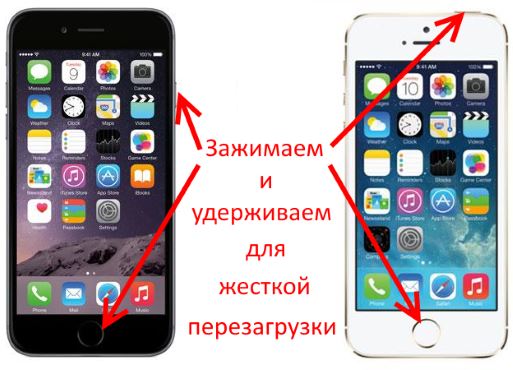Необходимо выполнить хард ресет (жесткую перезагрузку) iPhone, а способ по-старинке не работает? Вероятно, вы не знали, но процедура принудительной перезагрузки или жесткого перезапуска в iPhone 8, iPhone 8 Plus, iPhone X, iPhone XS, iPhone XR, iPhone 11, iPhone 11 Pro, iPhone SE 2, iPhone 12, iPhone 12 mini, iPhone 12 Pro, iPhone 13, iPhone 13 mini, iPhone 13 Pro изменилась.
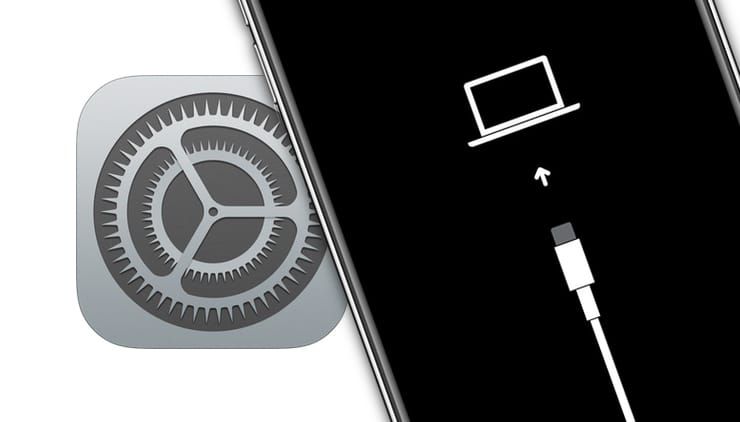
♥ ПО ТЕМЕ: В каком смартфоне самая лучшая камера в 2022 году – Топ 10.
Напомним, для принудительной перезагрузки iPhone 7 и iPhone 7 Plus нужно одновременно нажать и удерживать в течение не менее 10 секунд кнопки питания и уменьшения громкости до появления логотипа Apple. В iPhone 8, iPhone 8 Plus, iPhone X, iPhone XS, iPhone XR, iPhone 11, iPhone 11 Pro / Pro Max, iPhone SE 2, iPhone 12, iPhone 12 mini, iPhone 12 Pro / Pro Max процедура перезагрузки изменилась.
♥ ПО ТЕМЕ: Как настроить автоматическое удаление ненужных приложений на iPhone и iPad.
Как выполнить принудительную перезагрузку или жесткий перезапуск (хард ресет) iPhone 8, iPhone 8 Plus, iPhone X, iPhone XS, iPhone XR, iPhone 11, iPhone 11 Pro / Pro Max, iPhone SE 2, iPhone 12, iPhone 12 mini, iPhone 12 Pro / Pro Max, iPhone 13, iPhone 13 mini, iPhone 13 Pro / Pro Max
1. Нажмите и быстро отпустите кнопку увеличения громкости.
2. Нажмите и быстро отпустите кнопку уменьшения громкости.
3. Нажмите и удерживайте боковую кнопку до тех пор, пока не появится логотип Apple.
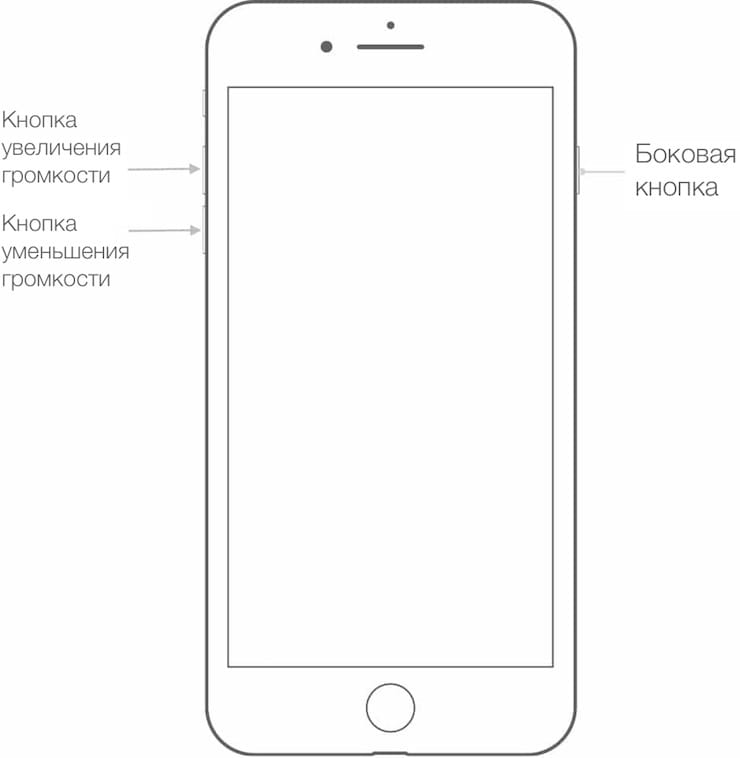
♥ ПО ТЕМЕ: Как изменить мелодию вызова (рингтон) на Айфоне.
Как выключить iPhone 8, iPhone 8 Plus, iPhone X, iPhone XS, iPhone XR, iPhone 11, iPhone 11 Pro / Pro Max, iPhone SE 2, iPhone 12, iPhone 12 mini, iPhone 12 Pro / Pro Max без использования кнопок
Для того чтобы выключить устройство, нужно нажать и удерживать в течение нескольких секунд кнопку увеличения громкости совместно с боковой кнопку до появления экранов со слайдерами.
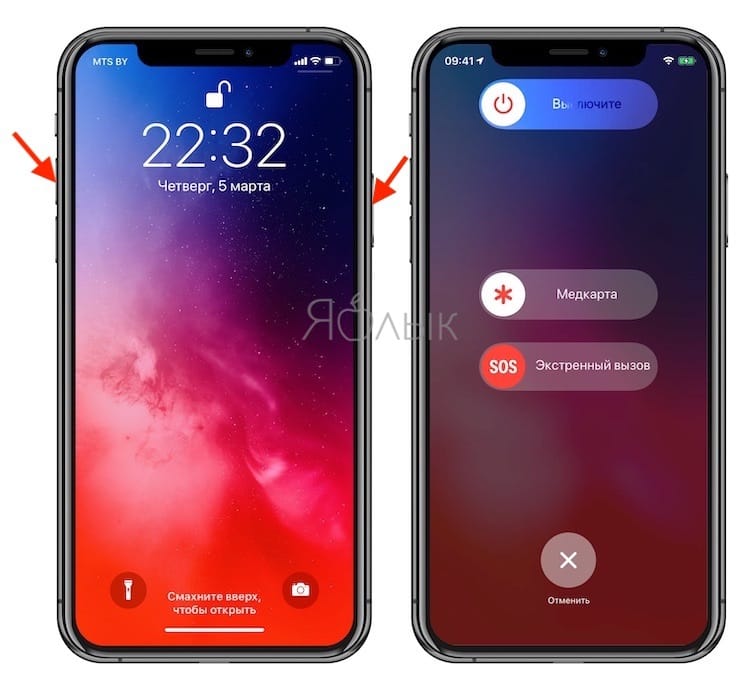
Кроме того, в iOS 11 и более новых версиях ПО опция «Выключить» также появилась в приложении «Настройки» (в самом низу раздела Основные).
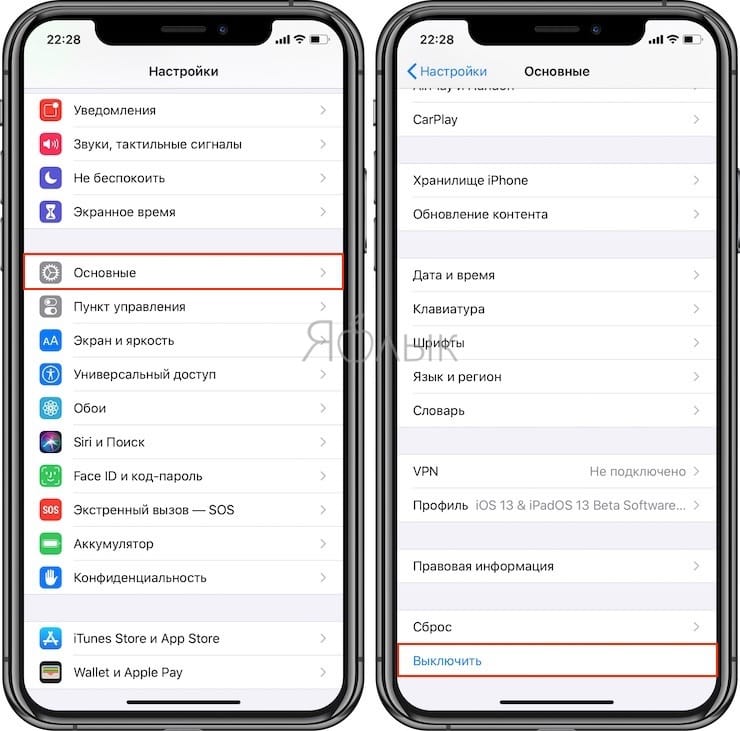
♥ ПО ТЕМЕ: Как выключить или перезагрузить iPhone, если не работает кнопка питания.
Как сбросить iPhone 8, iPhone 8 Plus, iPhone X, iPhone XS, iPhone XR, iPhone 11, iPhone 11 Pro / Pro Max, iPhone SE 2, iPhone 12, iPhone 12 mini, iPhone 12 Pro / 12 Pro Max, iPhone 13, iPhone 13 mini, iPhone 13 Pro / 13 Pro Max к заводским настройкам через «сброс настроек и контента»
Данная процедура выполняется так же, как и на всех других моделях iPhone. О том, как сбросить настройки в iPhone, мы подробно рассказывали в этом материале.
При возникновении трудностей с загрузкой системы применяют процедуру восстановления в программе iTunes на компьютере. В macOS 10.15 Catalina и последующих версиях вместо iTunes используется приложение Finder (подробно).
♥ ПО ТЕМЕ: Восстановить или Обновить iOS на iPhone и iPad – в чем разница?
Имейте в виду, что после сброса до заводских настроек или восстановления ПО на компьютере все хранящиеся на устройстве данные исчезнут, поэтому используйте этот способ только в случае крайней необходимости. Однако если у вас есть резервные копии файлов на компьютере или iCloud, после восстановления ПО вы сможете легко их восстановить.
♥ ПО ТЕМЕ: Какой iPhone лучше держит батарею? Сравнение времени автономной работы всех актуальных iPhone в 2022 году.
Как перевести iPhone 8, iPhone 8 Plus, iPhone X, iPhone XS, iPhone XR, iPhone 11, iPhone 11 Pro / Pro Max, iPhone SE 2, iPhone 12, iPhone 12 mini, iPhone 12 Pro / 12 Pro Max, iPhone 13, iPhone 13 mini, iPhone 13 Pro / 13 Pro Max в режим восстановления при помощи компьютера
Подготовьте компьютер
1. Убедитесь, что на вашем Windows ПК или Mac установлена самая последняя версия iTunes (скачать можно здесь). В macOS 10.15 Catalina и последующих версиях вместо iTunes используется приложение Finder (подробно).
2. Подключите iPhone к компьютеру и откройте iTunes. В macOS 10.15 Catalina и последующих версиях, запустите приложение Finder.
Выключите iPhone
1. Отключите iPhone от компьютера, если он подключен при помощи кабеля.
2. Выключите смартфон. Дальнейшние действия зависят от модели iPhone.
- Для iPhone X или более новой модели, iPhone SE (2-го поколения), iPhone 8 или iPhone 8 Plus, необходимо одновременно нажать и удерживать боковую кнопку и кнопку уменьшения громкости, дожидаясь появления ползунка выключения на экране.

- Если вы являетесь обладателем iPhone 7 / 7 Plus, iPhone SE (1-го поколения), iPhone 6s и более ранних моделей, то просто нажмите и удерживайте одиночную боковую кнопку, пока на экране не появится ползунок выключения.
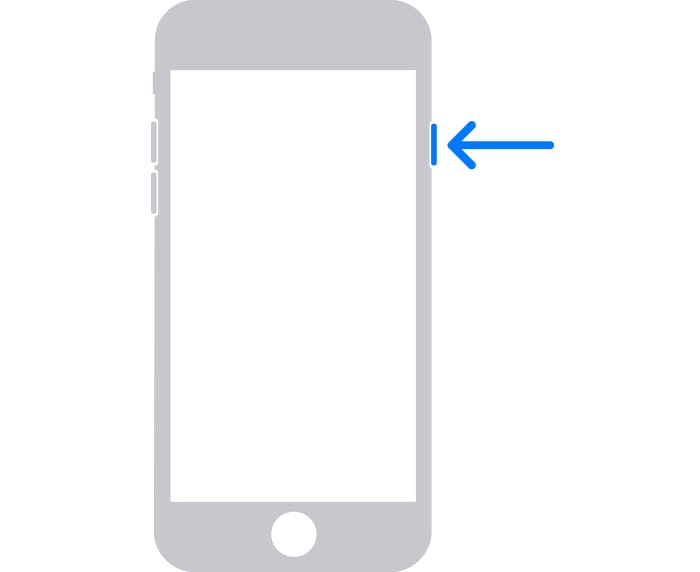
3. Сдвиньте ползунок, чтобы выключить iPhone.
♥ ПО ТЕМЕ: Как поделиться контактом на iPhone.
Переведите iPhone в режим восстановления
1. На iPhone найдите ту самую кнопку, которую вам понадобится удерживать.
- Если речь идет об iPhone X и последующих моделях, а также iPhone SE (2-го поколения), iPhone 8 или iPhone 8 Plus, то понадобится боковая кнопка.
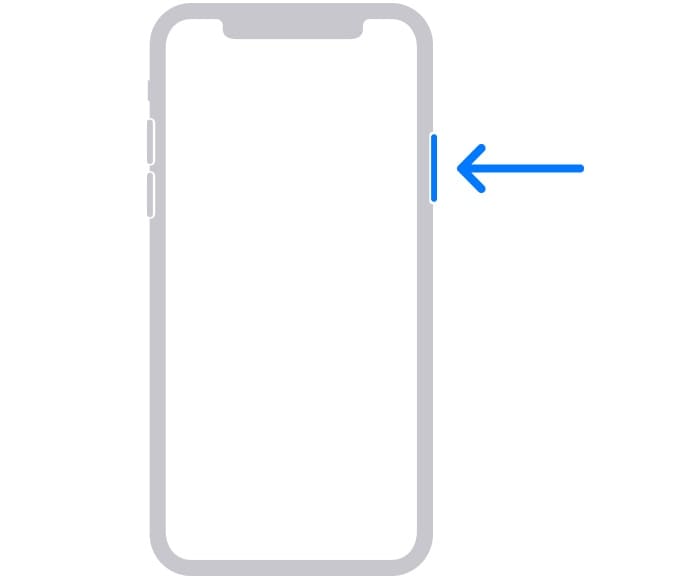
- На iPhone 7 и iPhone 7 Plus вы будете использовать кнопку уменьшения громкости.
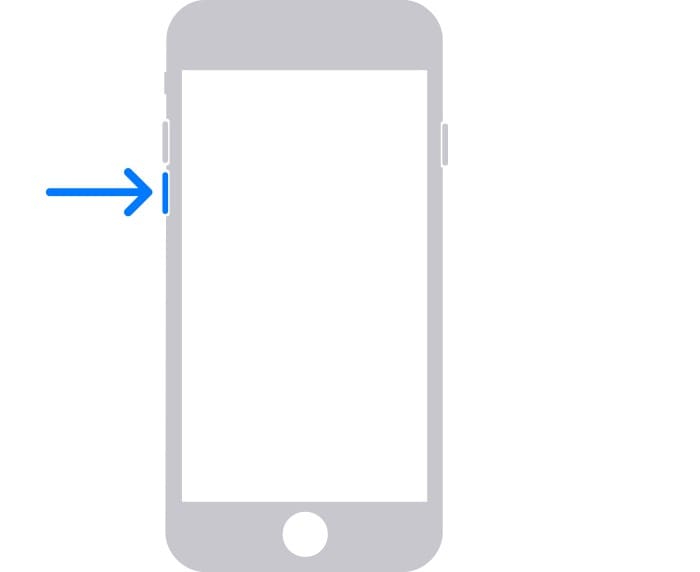
- Если же процедуре подвергаются iPhone SE (1-го поколения), iPhone 6s и более ранние модели, то понадобится кнопка «Домой».
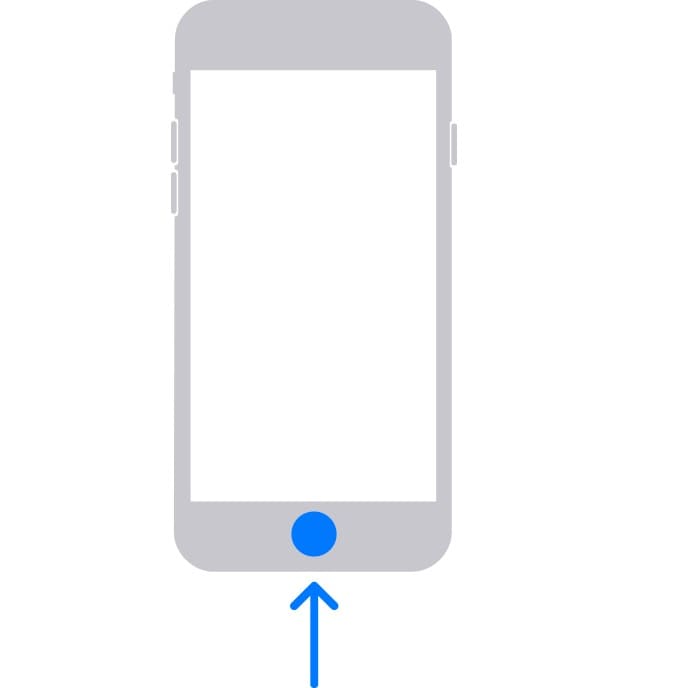
2. Нажмите и удерживайте кнопку, указанную выше для вашей модели iPhone. Сразу же, не отпуская палец от кнопки, подключите свой смартфон к компьютеру.
3. Удерживайте кнопку в нажатом состоянии, пока на экране iPhone не появится окно режима восстановления.

♥ ПО ТЕМЕ: Уведомления по расписанию на iPhone и iPad: как настраивать сводки?
Восстановление iPhone
В iTunes (или Finder в зависимости от ОС) появится меню, предлагающее либо восстановить, либо обновить iPhone. Выберите «Обновить», и iTunes (Finder) попытается переустановить iOS с сохранением данных или «Восстановить iPhone» для сброса настроек к заводским (все данные будут удалены).
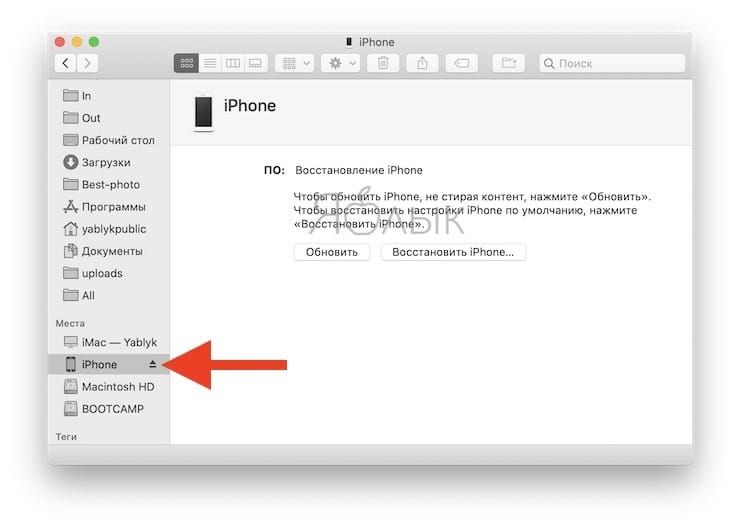
В процессе обновления или восстановления iPhone может несколько раз автоматически перезагружаться. Не стоит впадать в панику – дождитесь окончания загрузки (обычно 5-15 минут).
После завершения процесса восстановления или обновления настройте ваш iPhone.
Если вы по ошибке включили режим восстановления, а не обновления, не беспокойтесь. Просто отключите iPhone от компьютера и нажмите боковую кнопку для перезапуска. Режим восстановления будет отключен без необходимости восстанавливать или обновлять устройство.
Смотрите также:
- Как включить «одноручную» клавиатуру на iPhone для набора на ходу.
- Как открыть скрытый конвертер валют, физ величин и калькулятор на iPhone и iPad.
- Возможности iPhone при использовании ночью или в темноте.
Всем привет! Во многих статьях я пишу о том, что для решения некоторых проблем (да и просто для профилактики) операционной системы iOS необходимо выполнить жесткую перезагрузку устройства. Причем из статьи в статью я постоянно коротко описываю как это сделать. Честно говоря, мне это надоело.
Ну сколько можно писать одно и тоже?:)
Поэтому, было принято стратегическое решение — один раз написать подробную инструкцию о том, как выполнить жесткую перезагрузку (Hard Reset, как называют некоторые) iPhone и iPad, а потом просто давать ссылку на нее. По-моему, это просто гениальный ход мысли — ведь до такого практически невозможно додуматься! Как у меня это получилось… не знаю:) Ладно, хватит шутки-шутить, давайте уже переходить к главному.
Итак, жесткий сброс — это принудительная перезагрузка, которая может понадобиться в следующих случаях:
- Устройство зависло, тормозит и медленно работает.
- Вылетают какие-либо ошибки.
- Проблемы с беспроводными сетями, клавиатурой, программами, приложениями и т.д.
Обращаю ваше внимание, что подобная процедура не затрагивает никакие пользовательские данные, вся информация останется на своем месте, ничего не удалится. Если цель, которую вы преследуете делая жесткую перезагрузку, это стереть все с iPhone или iPad, то вам необходимо выполнить немного другую операцию, а именно, полный сброс настроек и контента — подробней тут.
Содержание:
- Любой iPhone до iPhone 7.
- iPhone 7.
- iPhone 8 и iPhone X.
- iPhone XS (XS Max) и iPhone XR.
- iPhone 11 (Pro, Pro Max) и iPhone SE (2020).
- iPhone 12 (mini, Pro, Pro Max).
- iPhone 13 (mini, Pro, Pro Max) и iPhone SE (2022).
- iPhone 14 (Plus, Pro, Pro Max).
Стандартная жесткая перезагрузка iOS-устройства
Почему в заголовке указано слово стандартная? Потому что до выхода iPhone седьмой модели, у всех iOS устройств обязательно присутствовали эти две механические кнопки. Так что если Ваш гаджет младше «семерки», то вот способ принудительно перезагрузить его:
- iPhone или iPad должен быть включен.
- Одновременно зажимаем две кнопки — Home (круглая под экраном) + Power (включения и блокировки).
- Не отпуская их, ждем того момента, пока iPhone или iPad не отключится.
- Продолжаем удерживать их до того пока не загорится экран.
Как выполнить жесткую перезагрузку iPhone 7
В iPhone 7 Apple добавила многое, но и убрала тоже не мало. В частности, клавиша Home перестала быть механической и скорей всего, так теперь будет во всех новых моделях. Так что старый способ, с зажатием кнопки домой не работает (нажимать то нечего). Как же теперь жестко перезагрузить iPhone?
- Устройство должно быть включено.
- Одновременно зажимаем и удерживаем две кнопки — Power (включения) и «Громкость вниз».
- Продолжаем держать обе клавиши до тех пор, пока экран не станет черным, а затем появится логотип Apple.
- Отпускаем кнопки.
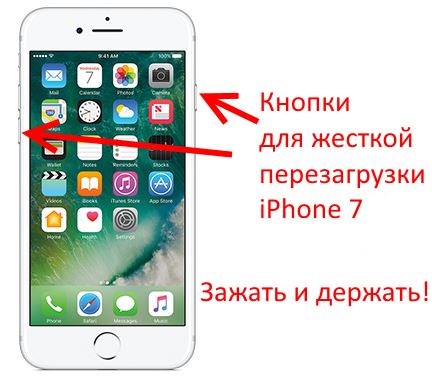
Таким образом, все манипуляции практически такие же как и в старых моделях, за исключением того, что теперь вместо клавиши Home используется кнопка «уменьшение громкости».
Как жестко перезагрузить iPhone 8 и iPhone X
Apple, выпустив iPhone 8 и iPhone X, полностью поменяла комбинацию кнопок для принудительного перезапуска этих устройств. Теперь, для того чтобы сделать Hard Reset нужно задействовать аж три кнопки, да еще и нажимать их в определенной последовательности. Готовы размять пальцы? Поехали!
Итак, жесткая перезагрузка iPhone 8 и iPhone X выполняется вот таким вот образом:
- Нажать и отпустить кнопку «увеличения громкости».
- Нажать и отпустить кнопку «уменьшения громкости».
- Зажать и держать боковую кнопку (включения) до того момента, пока на экране не появится логотип компании Apple.

Обратите внимание, что все нужно делать достаточно быстро. Нажали — отпустили, нажали — отпустили, зажали и держим.
Как сделать Hard Reset на iPhone XS, XS Max и XR? Инструкция!
В этот раз Apple не стала ничего придумывать — кнопки для жёсткой перезагрузки новых моделей iPhone 2018 года остались точно такими же, как и в iPhone X.
Ваш iPhone завис, вы не может пролистать эту статью чуть выше и посмотреть как делается Hard Reset? Ничего страшного! Я могу рассказать еще раз. Мне не тяжело.
Итак, инструкция. Принудительно и жестко перезагружаем iPhone XS, iPhone XS Max и iPhone XR:
- Нажимаем и отпускаем «Громкость вверх».
- Сразу же нажимаем и отпускаем «Громкость вниз».
- Сразу же жмем и держим кнопку «Включения» до момента появления «яблочка» (это займет около 10 секунд).
Повторюсь, все действия полностью идентичны iPhone X (см. картинку чуть выше).
Жесткая перезагрузка iPhone 11, iPhone 11 Pro, iPhone 11 Pro Max и iPhone SE 2 (2020)
Ждали чего-то нового и необычного? Не дождались.
Принудительная перезагрузка iPhone 11 (Pro Max) и iPhone SE 2 (2020) выполняется точно так же, как и в предыдущих моделях (начиная с iPhone 8).
Да-да-да, кнопки и порядок действий не изменился. Три простых шага:
- Нажать и отпустить «Громкость вверх».
- Нажать и отпустить «Громкость вниз».
- Удерживать кнопку включения.
Через секунд 10-15 ваш iPhone 11 (Pro Max) или iPhone SE 2 (2020) перезапустится. Поздравляю — вы успешно сделали Hard Reset!
Как принудительно перезагрузить iPhone 12 mini, iPhone 12, iPhone 12 Pro и iPhone 12 Pro Max
Стоит отметить, что Apple в очередной раз не придумала ничего нового.
Хотя… наверное, это правильно — ведь люди привыкли к определённой комбинации. Зачем что-то менять?
Поэтому, всё будет по старинке:)
Итак, вот инструкция, как сделать жесткую перезагрузку всех моделей iPhone 12:
- Нажать и отпустить «Громкость вверх».
- Нажать и отпустить «Громкость вниз».
- Нажать и удерживать кнопку включения.
Через некоторое время (секунд 10-15) ваш iPhone 12 (mini, Pro, Pro Max) перезагрузится. Победа!
Жесткая перезагрузка iPhone 13 mini, iPhone 13, iPhone 13 Pro, iPhone 13 Pro Max и iPhone SE (2022)
Не буду ходить вокруг да около, а сразу сообщу, что принудительная перезагрузка iPhone 13 и iPhone SE (2022) производится точно так же, как и в большинстве предыдущих моделей iPhone.
Работаем, так сказать, по старой схеме.
Вы скажите: «Автор, завязывай с загадками. Какая такая «старая схема»? Где комбинация кнопок? Куда нажимать-то?»
Я отвечу: «Всё, больше не буду. А по поводу комбинации и куда нажимать…»
Вот максимально подробная инструкция, как сделать жесткую перезагрузку всех моделей iPhone 13 и iPhone SE (2022):
- Нажать и отпустить «Громкость вверх».
- Нажать и отпустить «Громкость вниз».
- Нажать и удерживать кнопку включения.
Через некоторое время (секунд 10-15) ваш iPhone 13 (mini, Pro, Pro Max) или iPhone SE (2022) успешно перезагрузится. Ура!
Как принудительно перезагрузить iPhone 14, iPhone 14 Plus, iPhone 14 Pro и iPhone 14 Pro Max?
Легко. Почему? Потому что Apple в очередной раз не стала выдумывать велосипед и для iPhone 14 комбинация кнопок, которая позволит сделать жесткую перезагрузку устройства, ничем не отличается от большинства предыдущих моделей:
- Айфоны — новые.
- Инструкция по принудительной перезагрузке устройства — старая.
В общем, всё как обычно…
Итак, вот инструкция, как сделать жесткую перезагрузку любой модели iPhone 14:
- Нажать и отпустить «Громкость вверх».
- Нажать и отпустить «Громкость вниз».
- Нажать и удерживать кнопку включения.
Спустя некоторое время (10-15 секунд) ваш iPhone 14 (Plus, Pro, Pro Max) будет перезагружен и… Поздравляю — вы успешно сделали Hard Reset своего «четырнадцатого» iPhone! Счастье, радость и прочие классные эмоции:)
Согласитесь, что ничего сложного во всех вышеперечисленных манипуляциях нет — всё очень просто, быстро и легко.
Да и действительно, что может быть трудного в том, чтобы в определённой последовательности нажать (зажать или удерживать) две-три кнопки?:)
Но, несмотря на эту простоту, недооценивать значимость этой процедуры никак нельзя — сколько раз я использовал её для лечения зависших iPhone… Эх, были времена! Но это, конечно, немного другая история.
P.S. Хочешь получить правильную перезагрузку? Ставь «лайк» же! И вам польза, и автору будет приятно — заранее спасибо!
P.S.S. Если Ваш iPhone не хочет жестко перезагружаться, а также есть другие вопросы, то сразу же пишите в комментарии — попробуем разобраться!
Download Article
Download Article
Is your iPhone unresponsive? Performing a hard reset (or hard restart) of your iPhone is an easy way to restart your iPhone when pressing buttons or using the on-screen menu items isn’t working. Hard-resetting your iPhone requires pressing a certain button combination that varies by model. This wikiHow guide will teach you how to force a locked-up iPhone to restart, and show you what do if you can’t reset your phone.
-

1
Press and release the Volume Up button. It’s in the left side of the phone, close to the top-most edge.
- This method will work on the iPhone 8, 8 Plus, XR, XS, XS Max, 11, 11 Pro, 11 Pro Max, and iPhone SE (2nd Generation).[1]
- This method will work on the iPhone 8, 8 Plus, XR, XS, XS Max, 11, 11 Pro, 11 Pro Max, and iPhone SE (2nd Generation).[1]
-

2
Press and release the Volume Down button. It’s on the left side of the phone below the Volume Up button.
Advertisement
-

3
Press and hold the side button. It’s on the right side of the phone. Continue holding the button until the Apple logo appears.
-

4
Release your finger once the Apple logo appears. This should force-restart your unresponsive iPhone.
- If your iPhone still won’t restart, try charging it for an hour and then trying again.[2]
If you still can’t restart your iPhone, see Fixing an iPhone that Won’t Force-Restart.
- If your iPhone still won’t restart, try charging it for an hour and then trying again.[2]
Advertisement
-

1
Press and hold the Volume Down button and Sleep/Wake button. The Volume Down button is on the left side of the iPhone, and the Sleep/Wake button is on the top-most edge. Continue holding these buttons down until the Apple logo appears.
-

2
Release the buttons when you see the Apple logo. If the reset was successful, your iPhone will restart normally.
- If your iPhone still won’t restart, try charging it for an hour and then trying again. If you still can’t restart your iPhone, see Fixing an iPhone that Won’t Force-Restart.
Advertisement
-

1
Press and hold the Sleep/Wake button and the Home button. The Sleep/Wake button is on the top-most edge of the iPhone, while the Home button is the large round button at the bottom-center part of the screen. Continue holding the buttons down until you see the Apple logo.
-

2
Release the buttons when the Apple logo appears. Your iPhone should restart normally if the reset was successful.
- If your iPhone still won’t restart, try charging it for an hour and then trying again. If you still can’t restart your iPhone, see Fixing an iPhone that Won’t Force-Restart.
Advertisement
-

1
Connect your iPhone to a computer. If your iPhone gets hung up on the Apple logo or a solid-color screen when forcing it to restart, you can try using your PC or Mac to repair it without losing data. Start by connecting the iPhone to the computer using its charging cable.
-

2
Open Finder (Mac) or iTunes (PC). If you’re using Mac Catalina or later, click the two-toned face on the Dock to launch Finder. If you have Windows or an earlier version of macOS, open iTunes from the Start menu or Applications folder.
-

3
Locate your iPhone. If you’re using Finder, click your iPhone’s name in the left panel under «Locations.» If you’re using iTunes, click the button with an iPhone icon near the top-left corner of the app (to the right of the drop-down menu).[3]
-

4
Put your iPhone into recovery mode. The steps to do this vary by model:
- Models with Face ID: Press and release the Volume Up button, then press and release the Volume Down button. Press and hold the button on the top edge until your iPhone restarts in recovery mode.
- iPhone 8 or Later: Press and release the Volume Up button, then press and release the Volume Down button. Press and hold the button on the right side until the iPhone boots into recovery mode.
- iPhone 7/7 Plus: Press and hold the top button (or right-side button on some models) and the Volume Down buttons at the same time. Lift your fingers when the phone boots into recovery mode.
- iPhones with Home buttons, iPhone 6, and earlier: Press and hold the Home button and the top (or right-side) buttons at the same time. Lift your fingers when the recovery mode screen appears.
-

5
Click the Update button on your computer. This button is on the pop-up message that appeared in Finder or iTunes when the iPhone went into recovery mode. Choosing this option attempts to repair iOS without deleting your data.
- If this process fixes the iPhone, it will restart as normal.
- If it takes longer than 15 minutes to download the update, the iPhone will exit recovery mode automatically. In this case, repeat Step 4 to get back into recovery mode and then try again.
- If updating the iPhone was successful but you still can’t use it, you may have success with a factory reset. Just repeat this method and select Restore instead of Update. This will erase all of the data on your iPhone, so do this as a last resort.
-

6
Contact Apple Support if your iPhone still won’t restart. Apple recommends contacting their support team if you continue to experience any of these issues: The screen remains black or another solid color, the screen comes on but the iPhone won’t respond to your touch, or the iPhone remains stuck on the Apple logo.[4]
To reach out for support, visit https://getsupport.apple.com, select your model, and follow the on-screen instructions.
Advertisement
Add New Question
-
Question
If my iPhone is disabled, is there any way to get it working without losing my data?

If you’ve recently backed up your iPhone, you’ll be able to restore that backup after resetting your device, which will save your data. If you haven’t backed up your iPhone before, then there is no way to restore functionality and save your data. Everything will be wiped from the iPhone when you reset it.
-
Question
I forgot my Restrictions passcode, how can I reset my phone?

If you’ve forgotten your Restrictions passcode, you’ll need to restore your iPhone using iTunes. If you don’t have access to iTunes, you can sign into the iCloud website and select «Find My iPhone.» Select your device and choose «Erase» to reset it.
-
Question
I can’t remember my iPhone’s passcode, how can I factory reset it?

If you can’t remember your passcode to access the Settings, you’ll need to put your iPhone into Recovery mode and connect it to your computer. You can then use iTunes to reset the iPhone. See How to Put an iPhone into Recovery Mode for detailed instructions. Note that you’ll still need the Apple ID password after restoring the device.
See more answers
Ask a Question
200 characters left
Include your email address to get a message when this question is answered.
Submit
Advertisement
Video
Thanks for submitting a tip for review!
About This Article
Article SummaryX
If you have an iPhone 8, 8 Plus, or iPhone X, press the volume-up button, then volume-down, then the Power button. If you have an iPhone 7 or 7 Plus, press and hold the Power and volume-down buttons for 10 seconds. If you have an iPhone 6S or earlier, press and hold the Power and Home buttons for 10 seconds.
Did this summary help you?
Thanks to all authors for creating a page that has been read 6,896,550 times.
Is this article up to date?
Download Article
Download Article
Is your iPhone unresponsive? Performing a hard reset (or hard restart) of your iPhone is an easy way to restart your iPhone when pressing buttons or using the on-screen menu items isn’t working. Hard-resetting your iPhone requires pressing a certain button combination that varies by model. This wikiHow guide will teach you how to force a locked-up iPhone to restart, and show you what do if you can’t reset your phone.
-

1
Press and release the Volume Up button. It’s in the left side of the phone, close to the top-most edge.
- This method will work on the iPhone 8, 8 Plus, XR, XS, XS Max, 11, 11 Pro, 11 Pro Max, and iPhone SE (2nd Generation).[1]
- This method will work on the iPhone 8, 8 Plus, XR, XS, XS Max, 11, 11 Pro, 11 Pro Max, and iPhone SE (2nd Generation).[1]
-

2
Press and release the Volume Down button. It’s on the left side of the phone below the Volume Up button.
Advertisement
-

3
Press and hold the side button. It’s on the right side of the phone. Continue holding the button until the Apple logo appears.
-

4
Release your finger once the Apple logo appears. This should force-restart your unresponsive iPhone.
- If your iPhone still won’t restart, try charging it for an hour and then trying again.[2]
If you still can’t restart your iPhone, see Fixing an iPhone that Won’t Force-Restart.
- If your iPhone still won’t restart, try charging it for an hour and then trying again.[2]
Advertisement
-

1
Press and hold the Volume Down button and Sleep/Wake button. The Volume Down button is on the left side of the iPhone, and the Sleep/Wake button is on the top-most edge. Continue holding these buttons down until the Apple logo appears.
-

2
Release the buttons when you see the Apple logo. If the reset was successful, your iPhone will restart normally.
- If your iPhone still won’t restart, try charging it for an hour and then trying again. If you still can’t restart your iPhone, see Fixing an iPhone that Won’t Force-Restart.
Advertisement
-

1
Press and hold the Sleep/Wake button and the Home button. The Sleep/Wake button is on the top-most edge of the iPhone, while the Home button is the large round button at the bottom-center part of the screen. Continue holding the buttons down until you see the Apple logo.
-

2
Release the buttons when the Apple logo appears. Your iPhone should restart normally if the reset was successful.
- If your iPhone still won’t restart, try charging it for an hour and then trying again. If you still can’t restart your iPhone, see Fixing an iPhone that Won’t Force-Restart.
Advertisement
-

1
Connect your iPhone to a computer. If your iPhone gets hung up on the Apple logo or a solid-color screen when forcing it to restart, you can try using your PC or Mac to repair it without losing data. Start by connecting the iPhone to the computer using its charging cable.
-

2
Open Finder (Mac) or iTunes (PC). If you’re using Mac Catalina or later, click the two-toned face on the Dock to launch Finder. If you have Windows or an earlier version of macOS, open iTunes from the Start menu or Applications folder.
-

3
Locate your iPhone. If you’re using Finder, click your iPhone’s name in the left panel under «Locations.» If you’re using iTunes, click the button with an iPhone icon near the top-left corner of the app (to the right of the drop-down menu).[3]
-

4
Put your iPhone into recovery mode. The steps to do this vary by model:
- Models with Face ID: Press and release the Volume Up button, then press and release the Volume Down button. Press and hold the button on the top edge until your iPhone restarts in recovery mode.
- iPhone 8 or Later: Press and release the Volume Up button, then press and release the Volume Down button. Press and hold the button on the right side until the iPhone boots into recovery mode.
- iPhone 7/7 Plus: Press and hold the top button (or right-side button on some models) and the Volume Down buttons at the same time. Lift your fingers when the phone boots into recovery mode.
- iPhones with Home buttons, iPhone 6, and earlier: Press and hold the Home button and the top (or right-side) buttons at the same time. Lift your fingers when the recovery mode screen appears.
-

5
Click the Update button on your computer. This button is on the pop-up message that appeared in Finder or iTunes when the iPhone went into recovery mode. Choosing this option attempts to repair iOS without deleting your data.
- If this process fixes the iPhone, it will restart as normal.
- If it takes longer than 15 minutes to download the update, the iPhone will exit recovery mode automatically. In this case, repeat Step 4 to get back into recovery mode and then try again.
- If updating the iPhone was successful but you still can’t use it, you may have success with a factory reset. Just repeat this method and select Restore instead of Update. This will erase all of the data on your iPhone, so do this as a last resort.
-

6
Contact Apple Support if your iPhone still won’t restart. Apple recommends contacting their support team if you continue to experience any of these issues: The screen remains black or another solid color, the screen comes on but the iPhone won’t respond to your touch, or the iPhone remains stuck on the Apple logo.[4]
To reach out for support, visit https://getsupport.apple.com, select your model, and follow the on-screen instructions.
Advertisement
Add New Question
-
Question
If my iPhone is disabled, is there any way to get it working without losing my data?

If you’ve recently backed up your iPhone, you’ll be able to restore that backup after resetting your device, which will save your data. If you haven’t backed up your iPhone before, then there is no way to restore functionality and save your data. Everything will be wiped from the iPhone when you reset it.
-
Question
I forgot my Restrictions passcode, how can I reset my phone?

If you’ve forgotten your Restrictions passcode, you’ll need to restore your iPhone using iTunes. If you don’t have access to iTunes, you can sign into the iCloud website and select «Find My iPhone.» Select your device and choose «Erase» to reset it.
-
Question
I can’t remember my iPhone’s passcode, how can I factory reset it?

If you can’t remember your passcode to access the Settings, you’ll need to put your iPhone into Recovery mode and connect it to your computer. You can then use iTunes to reset the iPhone. See How to Put an iPhone into Recovery Mode for detailed instructions. Note that you’ll still need the Apple ID password after restoring the device.
See more answers
Ask a Question
200 characters left
Include your email address to get a message when this question is answered.
Submit
Advertisement
Video
Thanks for submitting a tip for review!
About This Article
Article SummaryX
If you have an iPhone 8, 8 Plus, or iPhone X, press the volume-up button, then volume-down, then the Power button. If you have an iPhone 7 or 7 Plus, press and hold the Power and volume-down buttons for 10 seconds. If you have an iPhone 6S or earlier, press and hold the Power and Home buttons for 10 seconds.
Did this summary help you?
Thanks to all authors for creating a page that has been read 6,896,550 times.
